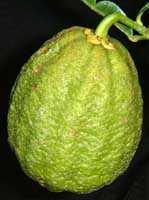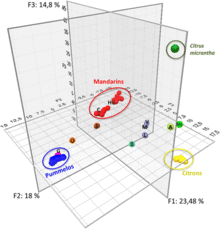Citrus subg. Papeda
| Papeda | |
|---|---|
 | |
| Ichang papeda | |
| Scientific classification | |
| Kingdom: | Plantae |
| (unranked): | Angiosperms |
| (unranked): | Eudicots |
| (unranked): | Rosids |
| Order: | Sapindales |
| Family: | Rutaceae |
| Genus: | Citrus |
| Subgenus: | Papeda |
| Species | |
|
15, see text. | |
Citrus subg. Papeda indicates the subgenus Papeda of the genus Citrus, with citrus species native to Asia.
Classification
The papeda group includes some of the most tropical, and also some of the most frost-tolerant citrus plants. They are cultivated far less often than other citrus, though they will all hybridize with other citrus. Many papedas are known for slow growth, small size relative to other citrus species, and thorniness. Though all papeda fruits are edible, many are considered unpalatable, or otherwise unfit for direct consumption by humans due to extremely sour or bitter flavors. Even so, a few papedas and papeda-hybrids (notably, Ichang lemon, Yuzu, Kaffir lime, Kabosu, and Sudachi) do have some culinary use. Other papedas, like the Ichang Papeda, have landscaping uses. The Ichang Papeda and Khasi are also of some importance as citrus rootstocks and in attempts at breeding new, disease-resistant or cold hardy citrus.
Species
The subgenus includes cultivated plants such as:
- Ichang Papeda
- Ichang lemon (pomelo x Ichang papeda)
- Yuzu (papeda x mandarin)
- Kaffir lime or Mauritius papeda
- Kabosu (ichang papeda x bitter orange)
- Sudachi (ichang papeda x mandarin orange)
(believed hybrid parentage in parends) and a number of wild and uncultivated species and hybrids, including:
- Citrus celebica (Celebes papeda)
- Citrus halimii (Mountain citron)
- Citrus latipes (Khasi papeda)
- Citrus longispina (Winged lime)
- Citrus macrophylla (Alemow)
- Citrus macroptera (Melanesian papeda)
- Citrus micrantha (Biasong)
- Citrus microcarpa (Samuyao)
- Citrus webberi (Kalpi)

Ancestor

-
Hybrids are expected to plot between their parents. ML: ‘Mexican’ lime; A: ‘Alemow’; V: ‘Volkamer’ lemon; M: ‘Meyer’ lemon; L: Regular and ‘Sweet’ lemons; B: Bergamot orange; H: Haploid clementine; C: Clementines; S: Sour oranges; O: Sweet oranges; G: Grapefruits.
It is believed, based on molecular studies,[1] that the citron, pomelo, mandarin and papeda were the ancestors of all other citrus species and their varieties, which resulted from breeding or natural hybridization among the parental species.
